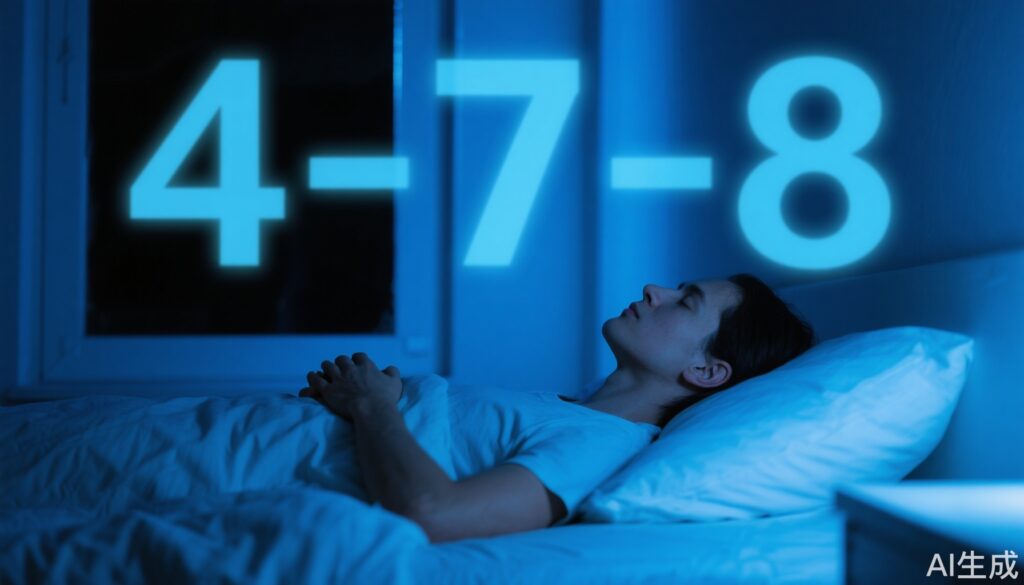Sleep—so vital, so elusive. Insomnia, whether it strikes as occasional sleeplessness or chronic tossing and turning, affects millions worldwide. In the quest for a good night’s rest, many turn to quick fixes: sleeping pills, herbal teas, or elaborate bedtime rituals. Yet, one seemingly simple technique has garnered attention both in wellness circles and clinical discussions: the so-called “Harvard 4-7-8 Breathing Method.”
Popularized by Dr. Andrew Weil, a Harvard-trained physician, the 4-7-8 breathing technique claims to help people fall asleep faster and improve overall sleep quality. But does this method truly live up to the hype, and what does science say about its effects on the mind and body?
Scientific and Clinical Evidence: What the Data Tell Us
The 4-7-8 breathing technique is straightforward: Breathe in through your nose for 4 seconds, hold your breath for 7 seconds, then slowly exhale through your mouth for 8 seconds. This cycle is repeated several times. The method is rooted in ancient pranayama practices from yoga, which emphasize controlling the breath to influence physical and mental states.
But how does it work from a scientific perspective? Slowing and controlling the breath stimulates the parasympathetic nervous system—the body’s “rest and digest” mode. This counters the stress-induced “fight or flight” response, lowering heart rate, reducing blood pressure, and promoting a sense of calm.
A 2018 study in the journal Frontiers in Human Neuroscience found that slow, paced breathing significantly reduced anxiety and improved heart rate variability—a marker of resilience to stress. While direct studies on the 4-7-8 method and sleep are limited, broader research on paced breathing and mindfulness suggests benefits for sleep onset and quality, especially in individuals experiencing anxiety or insomnia.
Case Vignette: A Nightly Struggle
Consider Jane, a 38-year-old marketing manager. After a stressful day, she would lie awake for hours, her mind racing through tomorrow’s to-do list. At her doctor’s suggestion, she tried the 4-7-8 breathing technique. Within a week of nightly practice, Jane found she could fall asleep more quickly and woke up feeling more rested. While not a substitute for treating underlying sleep disorders, this simple tool became an empowering part of her nighttime routine.
Misconceptions and Harmful Behaviors
With the popularity of the 4-7-8 method, myths abound. Some claim it’s a “miracle cure” for all sleep problems or that anyone can fall asleep in under a minute. Others use the technique as a substitute for necessary medical evaluation, potentially delaying diagnosis of conditions like sleep apnea, depression, or chronic insomnia.
Another misconception is that more is always better—some people overdo the technique, leading to lightheadedness or discomfort. And while breathing exercises are generally safe, they are not suitable for everyone. Individuals with certain respiratory or cardiovascular conditions should consult a clinician before beginning any new breathing regimen.
Correct Health Practices and Practical Recommendations
For those interested in trying the 4-7-8 breathing technique, here are some evidence-based tips:
– **Start slow:** If holding your breath for 7 seconds feels difficult, begin with shorter intervals and gradually increase as comfortable.
– **Create a calming environment:** Dim the lights, minimize distractions, and establish a regular bedtime routine.
– **Be consistent:** Practice the technique nightly, even if you don’t notice immediate results. Habits take time to form.
– **Don’t force it:** If you feel dizzy or uncomfortable, stop and resume normal breathing.
– **Seek help when needed:** If insomnia persists for weeks or interferes with daytime function, consult a healthcare professional.
Expert Insights and Commentary
While the 4-7-8 breathing method is not a panacea, many sleep specialists see value in incorporating it into broader sleep hygiene strategies. Dr. Lisa Chang, a clinical psychologist specializing in sleep medicine (fictional for illustration), notes: “Breathing exercises like 4-7-8 can be powerful tools for calming the mind and body. For patients with mild sleep difficulties or stress, they offer a low-risk, accessible approach. But for chronic or severe insomnia, a comprehensive evaluation is crucial.”
Researchers emphasize that breathing techniques often work best when combined with cognitive behavioral therapy for insomnia (CBT-I), regular physical activity, and attention to diet and screen time in the evenings.
Conclusion
The Harvard 4-7-8 breathing technique is not magic, but it’s more than mere hype. Grounded in the physiology of relaxation, it offers a practical, low-risk tool for managing stress and improving sleep for many people. As with any health practice, its greatest value lies in thoughtful, consistent use as part of a holistic approach to sleep health.
References
1. Jerath, R., Edry, J. W., Barnes, V. A., & Jerath, V. (2006). Physiology of long pranayamic breathing: Neural respiratory elements may provide a mechanism that explains how slow deep breathing shifts the autonomic nervous system. Medical Hypotheses, 67(3), 566-571.
2. Zaccaro, A., et al. (2018). How breath-control can change your life: A systematic review on psychophysiological correlates of slow breathing. Frontiers in Human Neuroscience, 12, 353.
3. American Academy of Sleep Medicine. Insomnia. https://sleepeducation.org/insomnia/
4. Weil, A. How to practice 4-7-8 breathing. https://www.drweil.com/health-wellness/body-mind-spirit/stress-anxiety/breathing-three-exercises/

